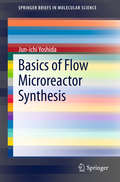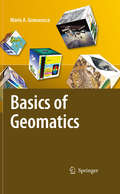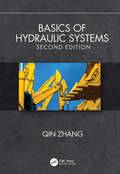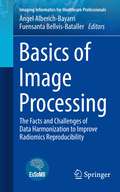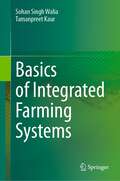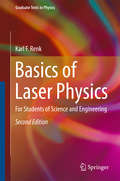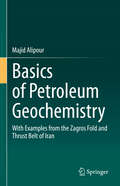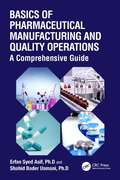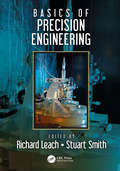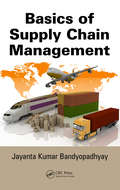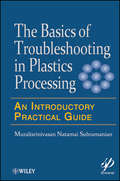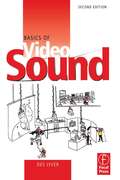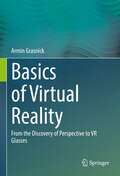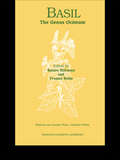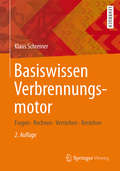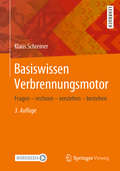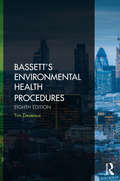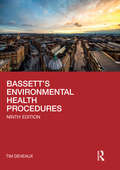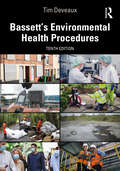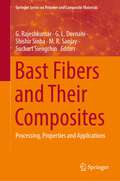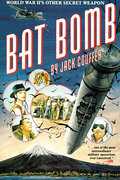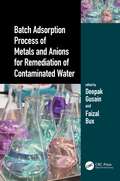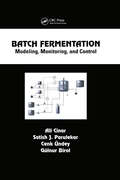- Table View
- List View
Basics of Flow Microreactor Synthesis (SpringerBriefs in Molecular Science)
by Jun-Ichi YoshidaThis book provides in a concise form the principles and applications of flow microreactors in organic and polymer synthesis. Recently, it became possible to conduct chemical reactions in a flow reactor in laboratory synthesis. The flow microreactor enables reactions that cannot be done in batch, opening a new possibility of chemical synthesis. Extremely fast mass and heat transfer and high-resolution residence time control are responsible for the remarkable features of that process. The book is not an exhaustive compilation of all known examples of flow microreactor synthesis. Rather, it is a sampling of sufficient variety to illustrate the concept, the scope, and the current state of flow microreactor synthesis. Researchers both in academia and in industry will be interested in this book because the topics encompassed by the book are vigorously studied in many university and company laboratories today.
Basics of Geomatics
by Mario A. GomarascaThis volume presents a comprehensive and complete treatment. In a systematic way the complex topics and techniques are covered that can be assembled under Geospatial Information namely, Geodesy, Cartography, Photogrammetry, Remote Sensing, Informatics, Acquisition Systems, Global Positioning Systems, Digital Image Processing, Geographic Information Systems, Decision Support Systems, and WebGIS. It describes in detail and at an accessible level - too much math has been avoided - the state of current knowledge. Per chapter a detailed bibliography has been included. As such, it will serve as a working tool not only to geoscientists and geographers but also to engineers, architects, computer scientists, urban planners, specialists in GIS, remote sensing, forestry, agricultural science, soil science geometry, environmental scientists and managers. Applications can be found in security, risk management, monitoring, info-mobility, geo-positioning, food traceability, etc. From the reviews: "The book is rigorous and synthetic, describing with precision the main instruments and methods connected to the multiple techniques today available. The objective pursued is to publish an integrated text, containing simple and comprehensible concepts relevant to experts in Geo-spatial Information." S. Dequal, Professor of Topography and Photogrammetry, DITAG, Polytechnic of Turin, Italy "This book fills a void of telling and showing the reader how remote sensing as a part of geomatics really works. With a clearly presented historical review up to the present time, the author illustrates the basic theories and use of the different remote sensing sensors and how to analyze the data from them for their application. This book would be a complement to the standard remote sensing books and I would highly recommend it for all land oriented professionals and especially graduate students who need a clear explanation of how remote sensing works". Chris J. Johannsen, Professor Emeritus of Agronomy, Department of Agronomy, Purdue University, West Lafayette, Indiana, USA "Basics of Geomatics" is structured in a clear and effective way into thematic chapters that provide a fundamental, yet comprehensive coverage of each of the major disciplines making up the field of Geomatics. Thanks to its clarity and completeness, the text, supplemented by many useful tables and illustrations will serve as a basic reference work for both beginners and experienced readers". John L. van Genderen, Professor, International Institute for Geoinformation Science and Earth Observation (ITC), Department of Earth Observation Science, Enschede, The Netherlands.
Basics of Hydraulic Systems, Second Edition
by Qin ZhangThis textbook surveys hydraulics and fluid power systems technology, with new chapters on system modeling and hydraulic systems controls now included.The text presents topics in a systematic way, following the course of energy transmission in hydraulic power generation, distribution, deployment, modeling, and control in fluid power systems.
Basics of Image Processing: The Facts and Challenges of Data Harmonization to Improve Radiomics Reproducibility (Imaging Informatics for Healthcare Professionals)
by Ángel Alberich-Bayarri Fuensanta Bellvís-BatallerThis book, endorsed by EuSoMII, provides clinicians, researchers and scientists a useful handbook to navigate the intricate landscape of data harmonization, as we embark on a journey to improve the reproducibility, robustness and generalizability of multi-centric real-world data radiomic studies. In these pages, the authors delve into the foundational principles of radiomics and its far-reaching implications for precision medicine. They describe the different methodologies used in extracting quantitative features from medical images, the building blocks that enable the transformation of images into actionable predictions. This book sweeps from understanding the basis of harmonization to the implementation of all the knowledge acquired to date, with the aim of conveying the importance of harmonizing medical data and providing a useful guidance to enable its applicability and the future use of advanced radiomics-based models in routine clinical practice. As authors embark on this exploration of data harmonization in radiomics, they hope to ignite discussions, foster new ideas, and inspire researchers, clinicians, and scientists alike to embrace the challenges and opportunities that lie ahead. Together, they elevate radiomics as a reproducible technology and establish it as an indispensable and actionable tool in the quest for improved cancer diagnosis and treatment.
Basics of Integrated Farming Systems
by Sohan Singh Walia Tamanpreet KaurThis volume on Integrated Farming Systems explains the diverse components that can be included in the agriculture sector. It is a practical guide to increasing a farm's productivity, profitability, and sustainability. The use of integrated farming systems has become essential with the growing population and the decreased availability of land resulting in the need to optimize the existing resources. By combining different farm enterprises like dairy, poultry, and fishery, farmers can achieve vertical expansion and increase their income and employment opportunities.This comprehensive guide covers all aspects of integrated farming systems, from the different components that can be included to the benefits of recycling crop residues and the by-products within the farm. With practical advice for small and marginal farmers, this book offers a roadmap for improving productivity and ensuring balanced nutrition for farm families. The book is suitable for a vast audience, from a farmer looking to increase profits and sustainability, a student of agriculture at the graduate or post-graduate level, or a researcher in the field of farming systems. It is an essential resource for reaping the benefits of integrated farming systems.
Basics of Laser Physics: For Students of Science and Engineering (Graduate Texts in Physics)
by Karl F. RenkBasics of Laser Physics provides an introductory presentation of the field of all types of lasers. It contains a general description of the laser, a theoretical treatment and a characterization of its operation as it deals with gas, solid state, free-electron and semiconductor lasers and, furthermore, with a few laser related topics. The different subjects are connected to each other by the central principle of the laser, namely, that it is a self-oscillating system. Special emphasis is put on a uniform treatment of gas and solid-state lasers, on the one hand, and semiconductor lasers, on the other hand. The discussions and the treatment of equations are presented in a way that a reader can immediately follow. The book addresses undergraduate and graduate students of science and engineering Not only should it enable instructors to prepare their lectures, but it can be helpful to students for preparing for an examination.
Basics of Petroleum Geochemistry: With Examples from the Zagros Fold and Thrust Belt of Iran
by Majid AlipourThis book provides a concise summary about fundamental aspects of petroleum geology and geochemistry for graduate students, primarily from non-English-speaking countries. These fundamentals constitute about 40% of the book, while the remaining 60% deals with regional examples from petroleum geology of the Zagros basin of Iran. The regional examples are prepared using both published and unpublished (proprietary) data. The aim is to familiarize readers with the fundamental aspects of petroleum geochemistry and then provide typical examples from one of the world&’s most prolific petroleum provinces.
Basics of Pharmaceutical Manufacturing and Quality Operations: A Comprehensive Guide
by Erfan Syed Asif Shahid Bader UsmaniThis book provides guidance on how to meet the requirements of the pharmaceutical industry as a beginner. It includes procedures for production and packaging, batch auditing as well as all quality measures used in the pharmaceutical industry. This book also provides questions and answers with each chapter for institutes and trainers providing basic training to the new graduates and new comers to the industry.Basics of Pharmaceutical Manufacturing and Quality Operations: A Comprehensive Guide is primarily written for anyone in the pharmaceutical industry interested in development and manufacturing of active pharmaceutical ingredient (API) and finished pharmaceutical manufacturers in both sterile and non‑sterile areas. The book is a simple, concise, and easy to use reference tool covering basic quality concepts required by the pharmaceutical educational institutions and professional certification bodies. It describes details of all GXP activities that are directly related to Quality, Safety, and Efficacy of the products manufactured under the umbrella of Quality Operations, common testing methods which are used in any modern industry, Requirements of Validation and Qualification of equipment, facilities and processes, integral segments of Drug product manufacturing, storage, and distribution practices. The material provides stepwise guidance on how to evaluate, audit, qualify, and approve a pharmaceutical product to enhance the GMP within the industry.The book is written with the idea of providing basic knowledge to undergraduate students who are preparing to enter the industry at the end of their graduation. The book would also be beneficial for institutions conducting pharmaceutical technology study courses in terms of GMP and GLP applications.Features: Provides readers and front line health care product manufacturers, all the information they need to know to develop a GMP oriented industry with trained and skilled personnel and manufacture products that meet GMP and regulatory requirements. Provides stepwise guidance on how to evaluate, audit, qualify, and approve a pharmaceutical product and packaging material to enhance the GMP within the industry. Includes significant processes and steps in production for all common dosage forms. Explains how in‑process and finished products are released. Provides an ideal and effective tool for anyone starting Quality Assurance/Quality control/Production responsibilities.
Basics of Precision Engineering
by Richard Leach Stuart T. SmithAdvances in engineering precision have tracked with technological progress for hundreds of years. Over the last few decades, precision engineering has been the specific focus of research on an international scale. The outcome of this effort has been the establishment of a broad range of engineering principles and techniques that form the foundation of precision design. Today’s precision manufacturing machines and measuring instruments represent highly specialised processes that combine deterministic engineering with metrology. Spanning a broad range of technology applications, precision engineering principles frequently bring together scientific ideas drawn from mechanics, materials, optics, electronics, control, thermo-mechanics, dynamics, and software engineering. This book provides a collection of these principles in a single source. Each topic is presented at a level suitable for both undergraduate students and precision engineers in the field. Also included is a wealth of references and example problems to consolidate ideas, and help guide the interested reader to more advanced literature on specific implementations.
Basics of Probability and Stochastic Processes
by Esra BasThis textbook explores probability and stochastic processes at a level that does not require any prior knowledge except basic calculus. It presents the fundamental concepts in a step-by-step manner, and offers remarks and warnings for deeper insights. The chapters include basic examples, which are revisited as the new concepts are introduced. To aid learning, figures and diagrams are used to help readers grasp the concepts, and the solutions to the exercises and problems. Further, a table format is also used where relevant for better comparison of the ideas and formulae. The first part of the book introduces readers to the essentials of probability, including combinatorial analysis, conditional probability, and discrete and continuous random variable. The second part then covers fundamental stochastic processes, including point, counting, renewal and regenerative processes, the Poisson process, Markov chains, queuing models and reliability theory. Primarily intended for undergraduate engineering students, it is also useful for graduate-level students wanting to refresh their knowledge of the basics of probability and stochastic processes.
Basics of Supply Chain Management
by Jayanta Kumar BandyopadhyayThe practice of supply chain management has become widespread in most industries. It is now included in the curriculum of many business schools in the United States and in many countries around the world. A number of professional associations, such as the American Production and Inventory Control Society and the Supply Chain Management Society, off
Basics of Supply Chain Management (Resource Management)
by Lawrence D. Fredendall Ed HillSupply Chain Management (SCM) was once a "pie in the sky" concept that could not be fully achieved. A key barrier was the cost of communicating with and coordinating among the many independent suppliers in each supply chain. SCM is possible because of three changes: technology has developed that simplifies communication, new management paradigms ha
Basics of Troubleshooting in Plastics Processing: An Introductory Practical Guide (Wiley-Scrivener #51)
by Muralisrinivasan Natamai SubramanianThe Basics of Troubleshooting in Plastics Processing is a condensed practical guide that gives the reader a broad introduction to properties of thermoplastics plastics, additives, the major processes (extrusion, injection molding, rotational molding, blow molding, and thermoforming), as well as troubleshooting. The main goal is to provide the plastics processor with an improved understanding of the basics by explaining the science behind the technology. Machine details are minimized as the emphasis is on processing problems and the defects in an effort to focus on basic root causes to problems and how to solve them. The book’s framework is troubleshooting in plastics processing because of the importance it has to the eventual production of high quality end products. Each chapter contains both practical and detailed technical information. This basic guide provides state-of-the-art information on: Processing problems and defects during manufacturing Plastics materials, their properties and characterization The plastics processing techniques Plastics additives Troubleshooting of the 5 main plastics processes References for further reading
Basics of Video Sound
by Des LyverNow fully updated to reflect the latest advances, the second edition of Basics of Video Sound is a primer for anyone wishing to learn about recording sound. It describes the principles and processes involved in obtaining professional results in educational, training and corporate environments. Assuming little prior knowledge, this book covers everything from how to choose a microphone and obtain the best quality recordings, to editing the results for the final screening. It features:· the latest advances in the use of disc and minidisc systems, computer based editing in audio post production· coverage of studio and location work· descriptions of the role of each crew member · full explanations of technical terms· health and safety precautions· practical advice on the equipment available and how to use itBasics of Video Sound aims to provide the reader with a rapid understanding of what is actually a complex process, without getting too bogged down in technical terms. It is equipment non-specific and references to technical matters are only included where necessary to understanding, for example a short explanation of the electricity and physics that is needed in order to become a good sound recordist.
Basics of Virtual Reality: From the Discovery of Perspective to VR Glasses
by Armin GrasnickToday, the reality we know can be recorded and reproduced true to reality using technical processes. Space and time are recreated virtually as a copy in artificial reality. However, the reproduction of virtual reality is not limited to a mere copy of what exists. A visitor to the virtual space does not have to be content with the pixelated image of the old familiar, but can encounter unreal phenomena in the illusory world that never existed in real life or are even physically impossible. This enables an expansion of the recorded reality and allows the perception of surprisingly new perspectives.A perspective denotes the perception of a fact from a certain point of view and corresponds to the way of looking at things. But a perspective is also the observation of a scene from a viewing position. From different perspectives the illusion of reality arises during the reproduction by observation. This vision is not based on imagination or hallucination, but is the basic function of virtual reality. This book describes the concepts, systems, and technologies used to create virtual reality from its ancient beginnings to the present, and provides a glimpse into a possible future.This book is a translation of the original German 1st edition Grundlagen der virtuellen Realität by Armin Grasnick, published by Springer-Verlag GmbH Germany, part of Springer Nature in 2020. The translation was done with the help of artificial intelligence (machine translation by the service DeepL.com). A subsequent human revision was done primarily in terms of content, so that the book will read stylistically differently from a conventional translation. Springer Nature works continuously to further the development of tools for the production of books and on the related technologies to support the authors.
Basil: The Genus Ocimum (Medicinal And Aromatic Plants - Industrial Profiles Ser.)
by Raimo Hiltunen Yvonne HolmCovering all the research areas regarding Ocimum such as botany, chemistry and pharmacology, this book will be of interest to everybody involved in medicinal and aromatic plant research or related fields.
Basiswissen Verbrennungsmotor: Fragen - rechnen - verstehen - bestehen
by Klaus SchreinerDieses etwas andere Lehrbuch führt in die Berechnung von Verbrennungsmotoren ein, indem es von aktuellen Fragestellungen z. B. der Fahrzeugdynamik oder Motorthermodynamik ausgeht und bei der Lösung die notwendige Theorie herleitet. Damit man in das Buch auch quer einsteigen kann, ist in einem eigenen Verzeichnis aufgeführt, welche theoretischen Kenntnisse man für die Lösung der jeweiligen Aufgabe benötigt und in welchem Abschnitt des Buches diese hergeleitet wurden. Alle Berechnungen werden in Excel durchgeführt. In der aktuellen Auflage wurden 20 völlig neue Fragestellungen mit aufgenommen.
Basiswissen Verbrennungsmotor: Fragen – rechnen – verstehen – bestehen
by Klaus SchreinerDieses besondere Lehrbuch führt in die Berechnung von Verbrennungsmotoren ein, geht dabei von aktuellen Fragestellungen z. B. zur Fahrzeugdynamik und Motorthermodynamik aus und stellt bei der Lösung die notwendige Theorie mit bereit. Damit auch Quereinsteiger erfolgreich sind, ist in einem Verzeichnis aufgeführt, welche theoretischen Kenntnisse man für die Lösung der jeweiligen Aufgabe benötigt und in welchem Abschnitt des Buches diese hergeleitet werden. Alle Berechnungen werden in Excel durchgeführt. In der vorliegenden Auflage wurden aktuelle Beispiele zur Motoreffizienz, zum Motorkennfeld, zur Lastpunktanhebung, zum Fahrzyklus WLTC und zu realen Fahrzyklen (RDE) ergänzt.
Bassett's Environmental Health Procedures
by Tim Deveaux W.H. BassettEnvironmental health law is a wide-ranging, detailed and complex body of law within the UK. Environmental Health Procedures is an established and essential reference source which provides an accessible entry into enforcement and administrative procedures for environmental health. The main legal procedures used in the environmental health field are presented as flow charts supported by explanatory text. The structure of this eighth edition has been revised for ease of use, with each chapter now addressing a single topic instead of a piece of legislation. It also introduces legal guidance for environmental health practitioners to prepare them for the court prosecutions that are an essential part of their work. The book has been updated throughout to reflect new practices, legislation and statutory guidance including: Primary Authorities Authorisations for public water supplies Infectious disease control Port Health RIDDOR Environmental permitting Environmental damage Imported food Empty homes Licensing of housing Licensing of gambling activities Environmental Health Officers/Practitioners and students will find this book invaluable. It will also be an essential reference for all those whose responsibilities demand they keep abreast of current environmental health practices.
Bassett's Environmental Health Procedures
by Tim Deveaux W.H. BassettEnvironmental health law is a wide-ranging, detailed and complex body of law within the UK. Bassett’s Environmental Health Procedures is an established and essential reference source which provides an accessible entry into enforcement and administrative procedures for environmental health. The main legal procedures used in the environmental health field are presented as flow charts supported by explanatory text. This ninth edition refines the structure introduced in the eighth edition, with each chapter addressing a single topic. It has introduced the titles of the corresponding legislation in Scotland and Northern Ireland where there is such legislation. The book has been updated throughout to reflect new practices, legislation and statutory guidance. Specifically, the ninth edition contains new content on Antisocial Behaviour and significant updates to sections on: Enforcement and Administration Environmental Protection Food Safety Housing and Public Health Environmental Health Officers/Practitioners and students will find this book invaluable. It will also be an essential reference for all those whose responsibilities demand they keep abreast of current environmental health practices.
Bassett's Environmental Health Procedures
by Tim Deveaux W.H. BassettBassett’s Environmental Health Procedures is a long-standing, must-have reference book for practising environmental health officers in local government and in private practice. It covers all the key legislative procedures for the service of a wide range of notices to deal with public health problems throughout the UK. The tenth edition covers the following subjects and reflects new practices, legislation and statutory guidance: The legal framework Environmental protection – including air quality, noise, pollution control Food safety Health and safety at work Housing Port health Public health Each procedure includes a simple description of the legislation and a flow diagram showing the procedure to follow in using that legislation. Written for the increasingly pressurised local authority environmental health practitioner, this book will help them to understand the legislation quickly and easily and how to deploy it effectively. Bassett’s is also an essential reference for all those whose responsibilities demand they keep abreast of current environmental health practices.
Bast Fibers and Their Composites: Processing, Properties and Applications (Springer Series on Polymer and Composite Materials)
by Suchart Siengchin G. Rajeshkumar Shishir Sinha G. L. Devnani M. R. SanjayThis edited book focuses on processing, properties, and applications of bast fiber and its composites written by renowned researchers and academicians. The contents focus on properties such as rheological and dielectric of bast fiber composites. It also discusses its dynamic mechanical analysis, thermal stability of polymer composites reinforced with bast fibers, and water absorption behavior of bast fiber incorporated polymer composites. This book will be beneficial to both the industry and academia as it highlights possible avenues of future research.
Bat Bomb: World War II's Other Secret Weapon
by Jack Couffer&“Inside information on a wondrously droll, highly classified yarn from WWII . . . A well-told, stranger-than-fiction tale that could make a terrific movie.&” —Kirkus Reviews The plan: attach small incendiary bombs to millions of bats and release them over Japan&’s major cities. As the bats went to roost, a million fires would flare up in remote crannies of the wood and paper buildings common throughout Japan. When their cities were reduced to ashes, the Japanese would surely capitulate . . . Told here by the youngest member of the team, this is the story of the bat bomb project, or Project X-Ray, as it was officially known. In scenes worthy of a Capra or Hawks comedy, Jack Couffer recounts the unorthodox experiments carried out in the secrecy of Bandera, Texas, Carlsbad, New Mexico, and El Centro, California, in 1942-1943 by &“Doc&” Adams&’ private army. This oddball cast of characters included an eccentric inventor, a distinguished Harvard scientist, a biologist with a chip on his shoulder, a movie star, a Texas guano collector, a crusty Marine Corps colonel, a Maine lobster fisherman, an ex-mobster, and a tiger. The bat bomb researchers risked life and limb to explore uncharted bat caves and &“recruit&” thousands of bats to serve their country, certain that they could end the war with Japan. And they might have—in their first airborne test, the bat bombers burned an entire brand-new military airfield to the ground. For everyone who relishes true tales of action and adventure, Bat Bomb is a must-read. Bat enthusiasts will also discover the beginnings of the scientific study of bats.
Batch Adsorption Process of Metals and Anions for Remediation of Contaminated Water
by Faizal Bux Deepak GusainAdsorption is one of the method that is in use for remediation of contaminated water. The experimental factors affecting the batch mode of adsorption of various metals and inorganic anions are discussed in this book. The elemental contaminants have been categorized into four major categories i.e. major toxic elements; essential elements having toxicity on excessive exposure; miscellaneous elements having undetermined effects; non-toxic elements having trivial or unidentified significance. In addition, anions like nitrate, perchlorate and sulphate as water contaminants are considered. This unique volume fills a niche in the area of water treatment. Key Features: Provides practitioners with the background they need to understand and apply batch adsorption processes to the purification of water Describes the actions of adsorption capacity or percentage removal with respect to factors affecting the adsorption process Excellent source of information for those working in the industry for remediation of metals and anions Discusses the current era of Anthropocene which is highly dependent on the anthropogenic mineral sources for its sustenance
Batch Fermentation: Modeling: Monitoring, and Control (Chemical Industries)
by Ali Cinar Satish J. Parulekar Cenk Undey Gulnur BirolIllustrating techniques in model development, signal processing, data reconciliation, process monitoring, quality assurance, intelligent real-time process supervision, and fault detection and diagnosis, Batch Fermentation offers valuable simulation and control strategies for batch fermentation applications in the food, pharmaceutical, and chemical industries. The book provides approaches for determining optimal reference trajectories and operating conditions; estimating final product quality; modifying, adjusting, and enhancing batch process operations; and designing integrated real-time intelligent knowledge-based systems for process monitoring and fault diagnosis.
